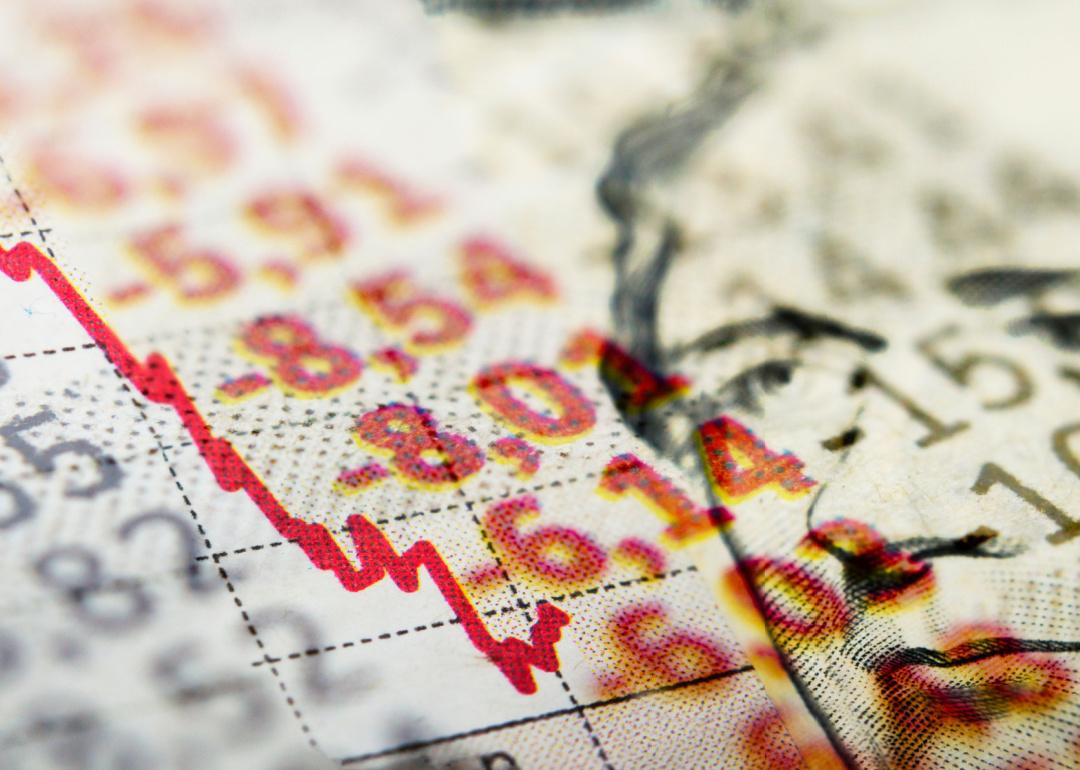Signs global bond markets could be bottoming out after central bank rate hikes

solarseven // Shutterstock
Signs global bond markets could be bottoming out after central bank rate hikes
Person checking financial charts on phone
Fixed-income investors are experiencing what could be the most challenging year for bond markets in 45 years, with 2022 shaping up to be possibly the worst since 1931.
Bonds are units of debt issued by companies or governments that are converted into tradable assets. They contain the loan terms, such as the interest payment, bond principal, and maturity date. Bonds essentially function as instruments used by governments and corporations for borrowing money. Although the stock market generates far more headlines, global bond markets are much larger in value than stock markets, with more than $100 trillion tied up in bonds worldwide versus $64 trillion in equities.
Investors generally demand higher interest rates for lending to governments over extended periods, reflecting the opportunity cost of tying up their money longer amid rising growth and inflation forecasts. On the other hand, short-term rates occasionally rise beyond longer-term yields, disturbing the bond markets’ usual trend. When the yield curve inverts, investors demand more interest to lend to the government over shorter periods. This abnormality implies that investors anticipate economic growth to decline soon. Historically, an inverted yield curve has been a strong indicator of a pending recession. This is especially true when the U.S. faces strong global headwinds from Europe, where the Russia-Ukraine war and related sanctions have created a painful energy price shock.
Many consider bonds safer alternatives to other investments, and Treasury bonds are among the safest government bonds. While bonds are less volatile and tend to outperform equities in times of economic hardship, this does not imply that they are a rock-solid investment or that you should only invest in bonds.
Olive Invest collected information about bond markets from various professional, expert, and news sources to paint a clearer picture of the U.S. bond market’s performance.
![]()

MDart10 // Shutterstock
Interest rates continue to increase, but at a slower pace
United States Federal Reserve Bank building
Two years into the worst pandemic in a century, the global economy still struggles with the COVID-19 pandemic’s lingering effects of diminishing economic growth and soaring prices. Specifically, the U.S. has been battling inflation since the economy picked up after COVID-19-related shutdowns of industries and disrupted supply chains. To curb inflation, the Federal Reserve has leveraged the tools at its disposal, primarily interest rate hikes and the threat of more. Most recently, the Fed hiked interest rates by 75 basis points. However, the pass-through effect on the bond market could cause bond prices to bottom out.
At first glance, the relationship between interest rates and bond prices might not be apparent. But upon closer examination, it becomes clear that when central banks hike interest rates, bond prices fall, ensuring the face value of the bond remains constant. This is known among future brokers studying for their securities licensing exams as the teeter-totter, likening bond prices and interest rates to a seesaw on a children’s playground. Because of the inverse relationship between interest rates and bond prices, a further decline in bond prices can be expected as the Fed continues to hike interest rates.

larry1235 // Shutterstock
Stock market volatility driven in part by risks from Europe cause investors to seek safe havens like Treasury bonds
United States savings bonds with American currency
Ideally, equity markets offer higher expected returns than fixed-income markets. However, they also carry higher risks of loss. The Fed’s aggressive rate hikes and the risks of emerging market bond defaults have combined with energy crisis-related factory furloughs in Germany and other European manufacturers to spook investors. The result has been a flight to safety, with institutional and individual investors turning to Treasury bonds.
Lower bond prices have begun to present lucrative opportunities for investors seeking yield but with safety. Short-term instruments currently offer rising yields at 4.48% for six months, 4.53% for one year, and 4.41% for two years, while longer maturities like the five- and 10-year bonds offer yields of 4.18% and 4.01%, respectively.

corlaffra // Shutterstock
Recession talk from business and political leaders pushes stocks lower, likely sending bonds higher
Stock market graph and dollar bill
As the Fed maintains its hawkish stance and Fed Chairman Jerome Powell indicates it will continue to hike rates aggressively, industry experts and investors are worried it may push the U.S. economy into recession.
The last time the Fed hiked rates aggressively to curb inflation was during the early 1980s under then-Fed Chairman Paul Volcker. The Volcker Fed rate hikes made borrowing money and mortgage rates so expensive that bank certificates of deposit insured by the Federal Deposit Insurance Corporation were yielding 18% in May 1981, close to the high-water mark of the severe recession of 1981-82.
Regarding the present outlook, Fed officials have stated that they want to keep raising interest rates well above the current range of 3% to 3.25%, leaving analysts to speculate how high rates could go. However, the costs of servicing global debt burdens governments have accrued over the last 40 years across the G7 nations, including the U.S., would make any Fed rate hike approaching those interest rates Americans witnessed in the early 1980s unbearable.
With interest rates rising faster than expected, the unanticipated impacts of quantitative tightening and the expected prolonged war in Ukraine are indicators analysts believe are likely tipping the U.S. economy into recession. Against this stark global backdrop, industry experts, such as JPMorgan Chase CEO Jamie Dimon, believe the S&P 500 could suffer a painful downturn. A negative outlook for the equity markets may drive investors, in turn, back into the fixed-income markets, resulting in higher bond prices.
This story originally appeared on Olive Invest and was produced and
distributed in partnership with Stacker Studio.